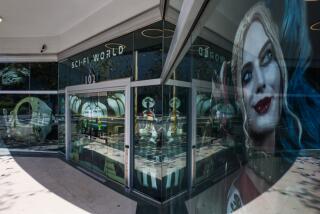Junk or Gems? Butterfield Auctioneers Will Tell You
It’s a bit cruel, I know, but in the interest of truth I must tell you, before you read any further, that that violin you picked up for $50 at the swap meet is not--repeat, not-- a Stradivarius.
OK, so it says Stradivarius when you look through the “f” holes, but violin makers have been doing that for a long time. It means the violin kinda, sorta, maybe looks like Antonio Stradivari’s original design. It’s a knockoff.
Real Stradivari stringed instruments show up in places like the Hermitage or the Louvre or under the chins of people like Itzhak Perlman and Jack Benny, and they are all lovingly accounted for by jittery insurance companies.
Yours was probably glued together at Crazy Leo’s World O’ Catgut.
Having said that, let me add that even though your violin may not be worth the gas it took to drive it home, there may be something else lying around the house--unappreciated, overlooked, forgotten in the general clutter--that may indeed be worth a few extra shekels.
This is, of course, the fondest dream of every rat-holer who ever drew breath: to make a quick and gigantic score by cashing in Grandma’s hand-painted teapot. Down the center aisle at Christie’s the lucky owner will stride, holding the teapot with the reverence of an imperial crown, the light glinting off the painted tableau of the Johnstown Flood, lovingly applied by Grandma herself. The auctioneer will gasp and hustle the owner into a plush anteroom, where he will be plied with Rothschild wine and money. The Johnstown Flood teapot is, after all, absolutely unique in the world.
That’s the dream. The reality is that, from a purely aesthetic standpoint, it’s a damn good thing the teapot is a one-of-a-kind item. Now, if the owner had come up with, say, one of Grandma’s old samplers, and Grandma happened to be Eleanor Roosevelt. . . .
Remember Eleanor if you decide to drop in on Butterfield & Butterfield’s free appraisal weekend, beginning today at the Los Angeles offices of the appraisers and auctioneers at 7601 Sunset Blvd. (Hours: 9 a.m. to 3 p.m. today, noon to 5 p.m. Sunday.) They say they’re the West’s oldest and largest full-service auction house, and they’ll have appraisers from both their Los Angeles and San Francisco offices on hand to--for free--turn thumbs up or down on your would-be treasures.
The categories are many: furniture and decorative arts, silver, paintings, prints, photographs, books, American Indian and ethnographic arts, rugs, Oriental art, jewelry, collectibles, coins and stamps, weaponry and wine. You may bring in as many as five items (or photographs of them if they’re too huge to bring in) at a time.
Here’s what they’re looking for, according to Pamela Tapp, a spokesperson for the house:
* The item should be the best example of its type.
* It should be representative of the time in which it was made.
* It should show superior workmanship.
* It should be in excellent condition.
* It should be a rare example.
“The more of these criteria something shows,” she said, “the more valuable it is.”
Conversely, a few things the appraisers often see, and thumb out, include such items as Limoges porcelain, miscellaneous teacups and saucers, Depression milk glass, limited edition collectibles (such as plates, Franklin Mint items and Hummel figures) and golden oak furniture. Such things, said Tapp, may have limited value elsewhere, but not on the auction market.
Occasionally, however, a gem emerges.
“For example,” said Tapp, “most people don’t think of their grandmother’s doll that’s been sitting in the attic for 80 or 100 years. But for a doll collector, if it’s rare and in good condition, it could be worth $500. That’s a shock to the average person.”
However, she said, perhaps visualizing boxcars full of dusty keepsakes arriving at Butterfield & Butterfield’s door, “that doesn’t mean everything in your attic or storage closet is going to be valuable.”
Sentimental value, she said, may increase with the years, but fair market value--the auctioneer’s yardstick--may not.
Still, said Tapp, “there’s an amazing range of material that people do and can bring in.”
Remember: a good, rare, representative example of its type and time, with good workmanship that has held up over the years. If you’ve got something like that lying around and are willing to part with it, an auctioneer may be willing to part with some decent walking-around money in return.
But don’t bring them sepia-tone photos of your hometown in Kansas and claim it was taken by Matthew Brady if there’s a McDonald’s in the foreground. Don’t bring them a Paul Revere tankard that’s stamped “Made in Korea.”
And don’t, don’t, don’t bring them anything that says Stradivarius on it, especially if it sounds like the catgut is still in the cat. Unless, of course, you can prove that it was played by Eleanor Roosevelt.
More to Read
More to Read
More to Read
The biggest entertainment stories
Get our big stories about Hollywood, film, television, music, arts, culture and more right in your inbox as soon as they publish.
You may occasionally receive promotional content from the Los Angeles Times.






